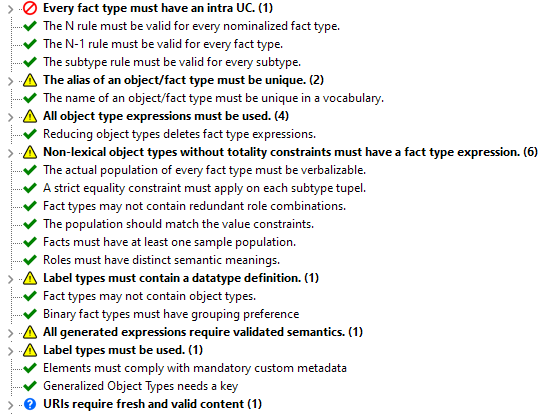Difference between revisions of "Modeler:Tutorial/Integrity Checks"
From CaseTalk Wiki
m |
|||
| (79 intermediate revisions by the same user not shown) | |||
| Line 1: | Line 1: | ||
= | = Model Well-formedness = | ||
This window shows the well-formedness rules for the active model. This window shows the basic rules to which your model should comply. It shows both errors and warnings. Errors need to be solved before any model generation can be started. Warnings are optional and are indicators to the modeler where to potentially improve the model. | |||
It is advised to perform these rule checks regularly to keep the model in order. | |||
[[File:ModelWellFormedness9.png]] | |||
The disablement of rules is saved inside the current project settings. | |||
= | = Full List = | ||
Click here for a full list of validation rules and their description: [[Modeler:12/RepositoryRules|Integrity Checks]]. | |||
---- | ---- | ||
Back: [[:Modeler:Tutorial/Subtype and Generalisation|Subtype and Generalisation]] | Back: [[:Modeler:Tutorial/Subtype and Generalisation|Subtype and Generalisation]] | ||
[[ | Next: [[:Modeler:Tutorial/Version Management|Version Management]] | ||
Latest revision as of 05:34, 4 July 2023
Model Well-formedness
This window shows the well-formedness rules for the active model. This window shows the basic rules to which your model should comply. It shows both errors and warnings. Errors need to be solved before any model generation can be started. Warnings are optional and are indicators to the modeler where to potentially improve the model.
It is advised to perform these rule checks regularly to keep the model in order.
The disablement of rules is saved inside the current project settings.
Full List
Click here for a full list of validation rules and their description: Integrity Checks.
Back: Subtype and Generalisation
Next: Version Management
